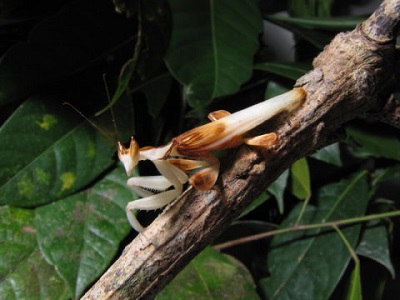A team of scientists discovered that the orchid mantis looks like a flower due to the exploitation of pollinating insects as prey by its praying mantis ancestors according to Science daily.
By studying the evolutionary relationships of the orchid mantis and its distant relatives, the team discovered that females in the orchid mantis lineage increased in size and changed color over their evolutionary history to gain advantage over large pollinating insects, such as bees, as well as the ability to attract them for predation. However, the morphologically dissimilar males are small and camouflaged, enabling them to live a life of predator avoidance and mate finding. The team found that this difference in males and females, termed sexual dimorphism, was likely the result of female predatory success that favored larger and more conspicuously colored individuals.
This result challenges the traditional explanation for sexual dimorphism in arthropods as an increase in female egg production and suggests female predation strategy led to the differing male and female ecologies in the orchid mantises.
Lead author Dr. Gavin Svenson and co-authors used their evolutionary reconstruction of the group to demonstrate that a size increase in floral associated mantises provided access to more prey options, which set the stage for the evolution of floral simulation through size, shape, and color modifications that helped attract insect pollinators as prey. Thanks to a body of ecological research on the orchid mantis previously conducted by co-author Dr. James O’Hanlon, it was known that females masquerade as flowers (floral simulation) to attract pollinating insects to eat, but that they do not sit on flowers themselves. This knowledge helped the team decipher the likely evolutionary scenario that gave rise to floral simulation in the orchid mantises and provided the opportunity to correct the long-held misunderstanding that orchid mantises sit on orchids, which their namesake incorrectly suggests.
“This study is a demonstration of how basic systematics research can inform our understanding of evolution by establishing patterns not previously seen,” said co-author Henrique Rodrigues.
“Bringing together ecological research with an evolutionary analysis enabled us to explain how such a remarkable, flower masquerading lineage of praying mantis could evolve,” said co-author Sydney Brannoch. Co-authors Rodrigues and Brannoch are both Ph.D. candidates.
The research project, under the direction of Svenson, was primarily focused on the systematics and taxonomy of a broader lineage of praying mantises, which included the orchid mantises. Acting on a suggestion made by co-author Dr. Frank Wieland, the team took notice of a small group of extremely large and colorful mantises that grouped together in the evolutionary analysis. Although these relationships were never before outlined, they suggested a clear pattern of extreme sexual dimorphism in the orchid mantis lineage.
“It was not our intention to study the orchid mantises specifically, but when a unique pattern emerges, one must pursue fascinating results,” said Svenson, curator of invertebrate zoology and adjunct assistant professor. “Finding the first case of males and females of a praying mantis species living extremely different adult lives was interesting and unique, but discovering the first case of arthropod sexual size dimorphism caused by female predatory success rather than investment in reproduction was both surprising and rewarding. This is particularly true when the original research focus was to fix the classification system to reflect true evolutionary relationship. Finding patterns in your study group that inform broader evolutionary understanding of systematics research.
N.H.Kh

